Dipole dipole forces Study guides, Class notes & Summaries
Looking for the best study guides, study notes and summaries about Dipole dipole forces? On this page you'll find 616 study documents about Dipole dipole forces.
Page 4 out of 616 results
Sort by
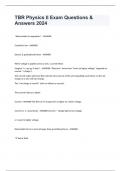
-
TBR Physics II Exam Questions & Answers 2024
- Exam (elaborations) • 50 pages • 2024
- Available in package deal
-
- $11.99
- + learn more
TBR Physics II Exam Questions & Answers 2024 *Electrostatics & magnetism* - ANSWER- Coulomb's law - ANSWER- Electric & gravitational forces - ANSWER- When voltage is applied across a wire, a current flows Imagine *e-'s go up V stairs* - ANSWER-*Electrons* move from *lower to higher voltage* (opposite to current "+ charge") The current makes electrons flow into the wire and out of the wire (equalling each other), so the net charge on a wire will not change. The *net charge i...
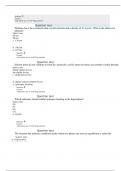
-
CHEM 101 exam 4 FALL 2023_Straighterline
- Exam (elaborations) • 8 pages • 2023
-
- $17.49
- + learn more
Platinum has a face-centered cubic crystal structure and a density of 21.5 g/cm3 . What is the radius of a platinumSelect one: a. 69 pm b. 98 pm c. 139 pm d. 196 pm e. 277 pm Question 2 Correct 4.60 points out of 4.60 Flag question Question text Helium atoms do not combine to form He2 molecules, yet He atoms do attract one another weakly through Select one: a. dipole-dipole forces. b. ion-dipole forces. c. dispersion forces. d. dipole-induced dipole forces. e. hydrogen bonding....
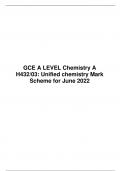
-
GCE A LEVEL Chemistry A H432/03: Unified chemistry Mark Scheme for June 2022
- Exam (elaborations) • 53 pages • 2023
-
- $18.49
- + learn more
GCE A LEVEL Chemistry A H432/03: Unified chemistry Mark Scheme for June 2022. Structure and bonding NH3 is (simple) molecular/simple covalent/ /has intermolecular forces AND NH4NO3 is ionic Comparison of strength Ionic bonds are stronger than intermolecular bonds / forces between molecules OR Ionic bonds need more energy to break than intermolecular bonds 2 AO1.1 ×2 For intermolecular bonds/forces ALLOW hydrogen bonds OR London Forces/induced dipole forces/permanent dipo...
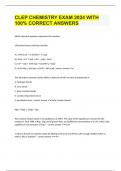
-
CLEP CHEMISTRY EXAM 2024 WITH 100% CORRECT ANSWERS
- Exam (elaborations) • 11 pages • 2024
-
- $16.49
- + learn more
Which chemical equation represents this reaction: a Bronsted-Lowry acid-base reaction A.) 2 KCLO₂(s) → 2 KCLO(s) + 3 O₂(g) B.) Zn(s) + Cu² + (aq) → Zn² + (aq) + Cu(s) C.) CO³ + (aq) + 6 NH (aq) → [Co(NH³)₆³+](aq) D.) H₂O+9aq) + NH₂(aq)→ H₂O(I) + NH₂+(aq) - correct answer The attractions between atoms within a molecule of NH3 are best characterized as A. hydrogen bonds B. ionic bonds C. polar covalent bonds D. London (dispersion) forces E. ion-dipole f...
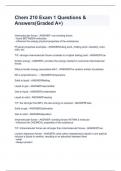
-
Chem 210 Exam 1 Questions & Answers(Graded A+)
- Exam (elaborations) • 10 pages • 2024
- Available in package deal
-
- $9.99
- + learn more
Chem 210 Exam 1 Questions & Answers(Graded A+) Intermolecular forces - ANSWER- non bonding forces - found BETWEEN molecules - influence the energy physical properties of the substances Physical properties examples - ANSWERboiling point, melting point, solubility, color, odor, etc. T/F: stronger intermolecular forces correlate to a higher boiling point - ANSWERTrue Kinetic energy - ANSWER- provides the energy needed to overcome intermolecular forces What is kinetic energy ass...
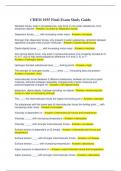
-
CHEM 1035 Final Exam Study Guide
- Exam (elaborations) • 14 pages • 2023
-
- $9.99
- + learn more
CHEM 1035 Final Exam Study Guide Weakest forces, exist in all substances, only force in non-polar substances, form temporary dipoles - Answer<>London or Dispersion forces Dispersion forces ____ with increasing molar mass - Answer<>increase Stronger than dispersion forces, only present in polar substances, attraction between oppositely charges ends of polar molecules - Answer<>Dipole-dipole forces Dipole-dipole forces ____ with increasing molar mass - Answer<>incre...
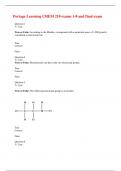
-
Portage Learning CHEM 210 exams 1-8 and final exam
- Exam (elaborations) • 124 pages • 2023
-
- $17.99
- + learn more
Portage Learning CHEM 210 exams 1-8 and final exam Question 1 3 / 3 pts True or False: According to the Module, a compound with a molecular mass of 1,000 g/mol is considered a macromolecule. True Correct! False Question 2 3 / 3 pts True or False: Biomolecules can have only two functional groups. True Correct! False Question 3 3 / 3 pts True or False: The following functional group is an alcohol. True Correct! False Question 4 3 / 3 pts True or False: In a eukaryotic cell, the organelles called p...
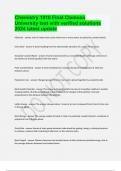
-
Chemistry 1010 Final Clemson University test with verified solutions 2024 latest update.
- Exam (elaborations) • 10 pages • 2024
- Available in package deal
-
- $14.99
- + learn more
Molecule Unit of matter that results when two or more atoms are joined by covalent bonds Ionic Bond A bond resulting from the electrostatic attraction of a cation for an anion. Brainpower Read More Nonpolar Covalent Bond A bond characterized by an even distribution of charge; electrons in the bonds are shared equally by the two atoms Polar Covalent Bond A bond resulting from unequal sharing of bonding pairs of electrons between atoms Polyatomic Ions Charged g...
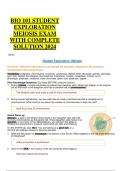
-
Chem 1202 Gizmos Student Exploration Polarity and Intermolecular Forces Questions with Correct Answers
- Exam (elaborations) • 10 pages • 2024
- Available in package deal
-
- $10.49
- + learn more
Chem 1202 Gizmos Student Exploration Polarity and Intermolecular Forces Questions with Correct Answers Answer Key Vocabulary: dipole, dipole-dipole force, dipole-induced dipole force, electronegativity, intermolecular force, ionic bond, London dispersion force, molecule, nonpolar, nonpolar covalent bond, partial charges, polar, polar covalent bond, valence electron Prior Knowledge Questions (Do these BEFORE using the Gizmo.) [Note: The purpose of these questions is to activateprior kn...
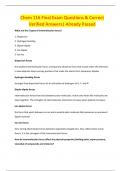
-
Chem 116 Final Exam Questions & Correct Verified Answers| Already Passed
- Exam (elaborations) • 14 pages • 2024
-
- $12.99
- + learn more
What are the 5 types of intermolecular forces? 1. Dispersion 2. Hydrogen bonding 3. Dipole-dipole 4. Ion-dipole 5. Ion-Ion Dispersion forces the weakest intermolecular force; a temporary attractive force that results when the electrons in two adjacent atoms occupy positions that make the atoms form temporary dipoles Hydrogen bonding forces stronger than dispersion forces its an attraction of hydrogen to O, F, and N Dipole-dipole forces intermolecular forces that exist between polar m...

$6.50 for your textbook summary multiplied by 100 fellow students... Do the math: that's a lot of money! Don't be a thief of your own wallet and start uploading yours now. Discover all about earning on Stuvia


